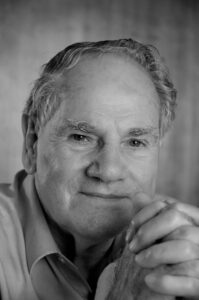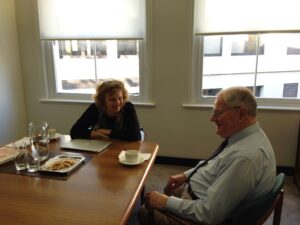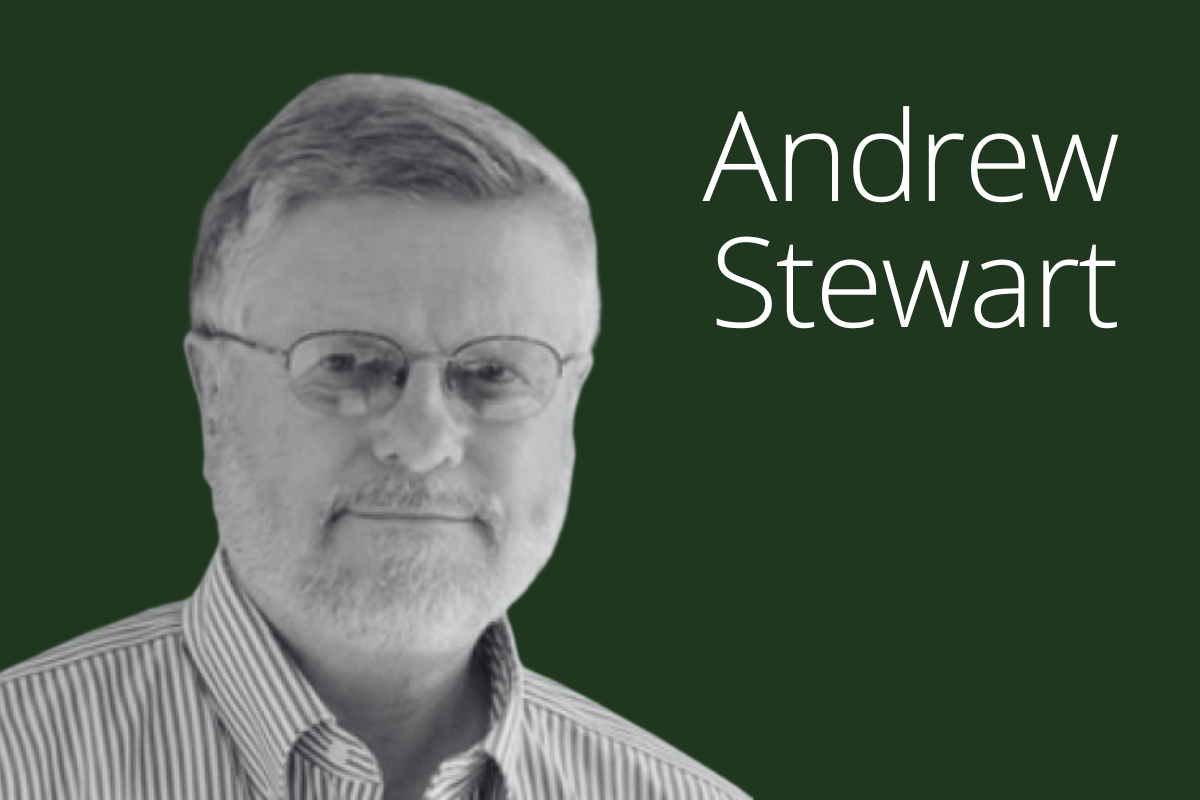
by John Elliott
inkjet print on paper
60.9 x 40.7 cm (image); 71.1 x 51.0 cm (sheet)
National Portrait Gallery of Australia
Commissioned with funds provided by Art Exhibitions Australia 2009
A charming, quietly spoken and well-suited gentleman, Robert ‘Bob’ Edwards AO FAHA had an old-world air that belied the ‘steely determination’ of an ‘inveterate strategist’ and ‘seasoned general’ (McDonald 2023). He leaves a remarkable legacy. Across his career, he was a pioneer in the systematic study of Australian rock art, founder and landmark director of some of Australia’s most important cultural institutions, consummate mandarin who established deep connections between Australia and the international art world and dedicated champion of Aboriginal and Torres Strait Islander rights.
Born in 1930 to an Adelaide family of orchardists, Bob Edwards’ early interest in history and archaeology is perhaps unsurprising given the influences of his childhood and youth. As a young person, he regularly accompanied a family friend, Gordon Ragless, to meetings of the Royal Geographical Society and the Royal Society of South Australia. His grandmother was a member of the Field Naturalists Society. He became fascinated with history and fine arts due to visits to an old curiosity shop on Rundle Street in Adelaide’s CBD. During his adolescence, he began to focus his interest on Australian history and Aboriginal stone tools, eventually leaving to pursue study in these fields at Monash University.
Bob Edwards gained field experience early in his career working in South Australia with anthropologist Draper Campbell and lithic expert Harold Cooper. His significant skills as a photographer (Edwards 1966a) resulted in his photos and film footage of rock art sites being used as references for contemporary rock art conservation projects.
In 1965, Edwards began his anthropological career at the South Australian Museum, succeeding Norman B. Tindale as curator of Australian Ethnology, and working alongside two other young curators, Bob Ellis and Graeme Pretty. Following in the steps of Herbert Basedow and Charles Mountford, Bob Edwards continued a long South Australian tradition of studying rock engravings in the mid north of South Australia. During this period, he conducted a systematic survey of rock art across the Olary region of South Australia, centred on Panaramitee station (e.g. Mountford and Edwards 1963).

While curator at the South Australia Museum, Edwards established a locked area in the basement of the museum and gave Aboriginal Elders from northern South Australian people the key. Archaeologist John Mulvaney stated that ‘I think that was the first attempt in Australia to acknowledge that there were secret sacred objects of importance to Aboriginal people where they could have the right to see them and the knowledge that other people would not be permitted because they were in this locked area’ (Creative Australia 2023).
One of Bob Edwards greatest scholarly contributions was in the shaping of rock art research in Australia (see Smith, Ross and Kimber 2020). Working at a time that archaeology was barely taught in Australian universities, he was one of the first scholars to apply a quantitative, comparative approach to the analysis and interpretation of rock art. His comparison of the frequency of different motifs at different localities in north-east South Australia and in Central Australia was a ground-breaking study in its time. Between 1962 and 1971, he published nine research papers on rock engravings (Edwards 1964, 1965a, 1965b, 1966b, 1968a, 1971; Mountford and Edwards 1962, 1963, 1964), as well as other papers on other significant sites in South Australia, such as Koonalda Cave (Edwards and Maynard 1967) and in the Northern Territory (Edwards 1966b). The approach that Edwards took to rock art, and to Aboriginal art more generally, responded to his deepening relationships with Aboriginal people, particularly those who were developing a new form of art at Papunya community in Central Australia. Mike Smith (2011) notes that:
While Bob initially saw the rock engravings as an ancient art lost to the present, a remnant of a distant prehistoric period, his later championing of the Papunya Tula art movement shows that he wasn’t locked into an antiquarian perspective. In a sense we get a picture of Bob, like many field workers, being transformed by the encounter with the desert and with Aboriginal people in the region.
In 1969, Bob Edwards received funding from The Australian newspaper to begin the huge project of systematically recording rock art across Central Australia. Over ten weeks, he travelled some 11,000 kilometres in a Land Rover that was not always reliable, visiting rock art sites in Central Australia, the Tanami Desert, the Anangu Pitjantjatjarra lands, and the Blackstone Range in Western Australia. He recorded the location of many significant sites including Puritjarra Cave, located by Kukatja-Luritja artist Timmy Tjukadai, and later excavated by Mike Smith, and deposited some 32,000 photos in the SA Museum collection. Published as a six-part serial in The Australian (Edwards 1970), this hugely important expedition had great impact on the Australian public’s appreciation of Aboriginal cultural heritage.
The 1960s and 70s were a formative period for the development of Australian archaeology and rock art research more broadly, it was also a period of major ethical and theoretical change within the social sciences. Edwards was at the forefront of these discussions, actively taking steps towards a more humanist approach to studying the past and recognising of rock art as part of living cultural traditions. He championed the importance of cultural patrimony to Aboriginal communities, actively working to empower Aboriginal stakeholders to be active participants in the management and interpretation of their own heritage.
From the early stages of his career, Bob Edwards was dedicated to increasing Australian people’s understandings of Aboriginal rock art and cultural heritage. Several of his books, including Australian Aboriginal Art (Edwards 1975), were squarely aimed at school children and a public audience. In a section on ‘Aborigines and the future’ in Australian Aborigines, Edwards was direct in expressing his views on the impact of colonisation on Aboriginal people:
For many years the settlers thought very little of the Aborigines and their culture. They did not realise how skilful the Aborigines were in being able to live off the land, as they had for many thousands of years. The settlers took the land from the Aborigines and did nothing for them in return … It is hoped that this book will create an interest in Aboriginal life which will lead many readers to find out more for themselves (Edwards 1974: 30).
Bob Edwards was a formidable and visionary leader who shaped the strategic directions of key Australian cultural organisations. In addition to his formal administrative posts, he held many board positions, including being founding chairman of the National Museum of Australia and of the National Portrait Gallery. In 1973, Edwards was appointed as Deputy Principle of the Australian Institute of Aboriginal Studies in Canberra, where he influenced the Hope enquiry into the national estate, an unprecedented enquiry into the interrelationships between natural, Indigenous and historical heritage, which recommended establishment of the Australian Heritage Commission.
In 1975, Bob Edwards become founding director of the Aboriginal Arts Board of the Australian Council for the Arts during a period that saw a massive expansion of Government support for Indigenous arts. In the latter position, Edwards initiated ground-breaking projects including copyright in Indigenous art works, the establishment and ongoing support of arts centres within communities, a literacy program to support Aboriginal Australians to record their own histories and cultural knowledge, Australian involvement in the Festival of Pacific Arts, and the commissioning, funding and delivery of major overseas tours of collections of Aboriginal art (Creative Australia 2023).
Bob Edwards was trusted by Aboriginal people. Wandjuk Marika, Chair of the all-Indigenous Aboriginal Arts Board, which often met on Country, when asked about working with Bob said: “Oh, we know, we look into the eyes. We can tell. He is the chosen one to do what we want him to do” (Eccles 2023).
In 1980, Bob Edwards became the founding executive director of the International Cultural Corporation of Australia which would later become Art Exhibitions Australia. In this position he negotiated some of the most successful international exhibitions to visit Australia. These included the first exhibition of the terracotta warriors to be held outside of China, The Entombed Warriors (1982), the blockbuster Gold of the Pharoahs (1988), the impressionist exhibitions Golden Summers (1985) and Claude Monet (1985), as well as exhibitions of Van Gogh (1993), and Rembrandt (1997). Journalist John McDonald (2023) provides an insight into Bob Edwards as a director of major cultural institutions:
Bob has the strange distinction of having exerted an immense influence on these institutions, while being almost invisible to the general public. This wasn’t due to a PR failure, or terminal shyness, it was a deliberate strategy, whereby Bob made the crucial contacts and often the important decisions, while others got the glory. Under his stewardship, Art Exhibitions Australia (AEA) quickly established itself as this country’s major international exhibitions agency, and it has remained so to this day.
In 1985 Edwards moved from Sydney to Melbourne where he became founding director of the Museum of Victoria. Later, he returned to Sydney where he worked primarily with Art Exhibitions Australia. He generously encouraged other scholars until the end of his life and maintained an office at the Rocks in Sydney well into his eighties.

Bob Edwards’ public service has been recognised broadly, most notably through being appointed an Officer of the Order of Australia (AO) in 1989 for service to conservation and the environment, particularly through museum organisations, having a bronze portrait medal struck to honour him as Founding Director of the Museum of Victoria (Museums Victoria 2020), having his portrait in the National Gallery of Australia, and in the Australian National Museum in Canberra holding a day of celebrations in his honour in 2011.
Both within and outside of his professional life, Bob Edwards was a passionate bibliophile. He donated his generous library of rare volumes on Australian heritage, archaeology, and social history to the National Museum of Australia. In their promotion of books from the Robert Edwards AO collection Hordern House (2013) state:
There cannot be a single Australian who has not been in in some way affected by Robert Edwards. Guiding spirit at different times to many of our most important cultural institutions, collector extraordinaire, progenitor of the so-called “blockbuster” exhibitions and long-term director of Art Exhibitions Australia, anthropologist and archaeologist, founding director of the Aboriginal Arts Board, early and passionate advocate of Aboriginal art and specifically the Papunya Tula movement… The list is endless.
Bob Edwards published his first paper in 1954 on the history of his local church, St Mary’s on Sturt Road, Marion. In 1952 he married his wife, Kath, in this church, the second oldest church in South Australia. In 2016, his wife pre-deceased him. He is survived by their four sons: Andrew, Martin, David and Greg.
Bob Edwards was a deeply learned scholar, an inspirational teacher and a skilful, ethical and visionary director of some of Australia’s major cultural institutions. His research and public service enhanced international appreciation of Australian art and significantly influenced how people today understand Indigenous Australians and their culture. The impact of his work is profound and ongoing. It is embedded in the structures and programs that he created and it lives on in the people he educated through books, photographs, films and exhibitions. His passing truly is a terrible loss.
Professor Claire Smith FAHA
Flinders University
References:
Creative Australia 2023 The Australia Council for the Arts acknowledges the passing of Dr Robert Edwards AO. Retrieved 13 March 2024 from https://creative.gov.au/news/media-releases/vale-dr-robert-edwards-ao/.
Eccles, J. 2023 Art facilitator took recognition of Indigenous culture to a new level. Sydney Morning Herald, June 13, 2023. Retrieved 13 March 2024 from https://www.smh.com.au/national/art-facilitator-took-recognition-of-indigenous-culture-to-new-level-20230605-p5de03.html.
Edwards, R. 1964 Rock engravings and stone implements of Pitcairn station, north-eastern South Australia. Records of the South Australian Museum 14:643–662.
Edwards, R. 1965a Rock engravings and incised stones: Tiverton Station, northeast South Australia. Mankind 6: 223–231.
Edwards, R. 1965b Rock engravings and Aboriginal occupation at Nackara Springs in the north-east of South Australia. Records of the South Australian Museum 15:9–29.
Edwards, R. 1966 Aboriginal art sites in the Northern Territory and the use of the camera in anthropological field work. Anthropological Society of South Australia Journal 4: 4.
Edwards, R. 1966b Comparative study of rock engravings in south and central Australia, Transactions of the Royal Society of South Australia 90: 33–38.
Edwards, R.1968a Unique rock art in Central Australia. Hemisphere, May:2–7.
Edwards, R. 1968b Prehistoric rock engravings at Thomas Reservoir, Cleland Hills, western Central Australia. Records of the South Australian Museum 15: 647–670.
Edwards, R. 1970 The rock engravers—parts 1–6. The Australian (Sydney) April 14–19.
Edwards, R. 1971 Art and Aboriginal prehistory. In J. Mulvaney and J. Golson (eds) Aboriginal Man and Environment in Australia, pp. 356–367. Canberra: Australian National University Press.
Edwards, R. 1974 Australian Aborigines. Canberra: Australian Institute of Aboriginal Studies.
Edwards, R. (ed.) 1975 Australian Aboriginal Art. The Art of the Alligator Rivers Region, Northern Territory. Canberra: Australian Institute of Aboriginal Studies.
Edwards, R. and L. Maynard 1967 Prehistoric art in Koonalda Cave, Proceedings of the Royal Geographical Society of Australasia, South Australian Branch 68:11–17.
Hordern House 2013 The collection of Robert Edwards AO. Retrieved 13 March 2024 from https://www.hordern.com/edwards-collection.php
McDonald, J. 2023 Bob Edwards: A eulogy. Retrieved 13 March 2024 from https://www.johnmcdonald.net.au/2023/bob-edwards-a-eulogy/
Mountford, C.P. and R. Edwards 1962 Aboriginal rock engravings of extinct creatures in South Australia. Man 62:97–99.
Mountford, C.P. and R. Edwards 1963 Rock engravings of Panaramitee station, north-eastern South Australia. Transactions of the Royal Society of South Australia 86: 131–146.
Mountford, C.P. and R. Edwards 1964 Rock engravings in the Red Gorge, Deception Creek, northern South Australia. ANTHROPOS: International Review of Anthropology and Linguistics 59:849–859.
Museums Victoria 2020 Medal—Robert Edwards, Museum of Victoria, Australia, 1990. Retrieved 13 March 2024 from https://collections.museumsvictoria.com.au/items/280707.
Smith, M.A., J. Ross and R.G. Kimber 2020 Robert Edwards and the history of Australian rock art research. Historical Records of Australian Science 32 1:41-51.



